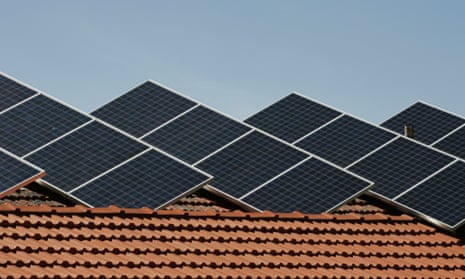People sweltering without an air conditioner in south-east Australia's heatwave are subsidising the power bills of those who use the energy-hungry appliances by at least $250 a year because of a tariff system the power industry and experts say is unsustainable.
The inequity arises because the cost of the hugely expensive network of "poles and wires" needed to guarantee uninterrupted power supply during massive short-term spikes in demand – for example when air conditioners are turned on during heatwaves – is spread evenly across all users.
Research by the Centre for Policy Development released late last year concluded that the 30% of Australians without air conditioners are subsidising the cost of the electricity network needed only to supply power to those with air conditioners by at least $250 a year. A similar study by the Productivity Commission, which also took into account the cost of generating the power, put the effective subsidy at $350 a year.
Grattan Institute energy program director Tony Wood says the solution has to include some form of differentiated pricing, with the portion of an electricity bill earmarked to pay for the distribution network no longer levied uniformly per unit of power used, but increased for those who routinely use more power at times of peak demand, for example homes with multiple air conditioners.
“The current system is unfair,” he says, likening it to building a multi-lane highway across the Sydney Harbour bridge so there were never traffic jams even at peak hour but charging everyone, whether they used it or not.
But tariff reform, which will be canvassed in the government’s forthcoming energy white paper, enters dangerous political territory.
With network costs now comprising about 45% of the average household bill, spreading them out more equitably across users could have a much bigger impact on bills, both up and down, than the proposed repeal of the carbon tax, which added on average a one-off increase of 9% or about $200 a year for the typical home.
According to the Energy Supply Association of Australia (ESAA), 73% of Australian homes had an air conditioner in 2011 compared with 35% in 1999. The Committee for Economic Development of Australia found that air conditioners bought for $1,500 frequently imposed a $7,000 cost on the energy system.
The inequitable increase in electricity costs has been exacerbated by the huge uptake of rooftop solar panels, the ESAA and the Grattan Institute argue, because solar households avoid the high network charges levied evenly across units of power used, but actually demand power from the grid just as much during those peak times which contribute most to the costs of the network.
“Households with solar end up paying less for the network because they generate some of their own electricity and import less from the grid. But solar households can be among the biggest users of the networks, because they both import and export electricity at different times of the day,” ESAA says in a discussion paper titled "Who pays for solar energy?".
“Most solar households end up only paying a fraction of their fair share of the cost of maintaining the network. They’re not doing it deliberately, it’s just the way the billing arrangements for electricity were set up, long before rooftop solar reached the scale we see today.”
But in a study for the Australian PV network, the Centre for Policy Development found that solar photo-voltaic panels actually reduced the cross subsidy because to whatever extent solar is operating during times of high demand, it reduces that demand.
The ESAA and the Grattan Institute say that if the government does nothing, power bills could rise even further as the market enters a “death spiral” – where fewer customers are forced to pay the high fixed costs of the electricity network, encouraging even more customers to turn to rooftop solar to reduce their bills, increasing still further the inequity in the electricity billing system.
“An increasing proportion of consumers no longer pay their fair share of network costs,” ESAA said in another discussion paper titled “Air conditioners and solar: why electricity pricing needs to be reformed”.
It says Queensland, with its high uptake of both air conditioners and rooftop solar, could already be in the early stages of a “death spiral” as a result of the current system – where higher bills push still more households to take up rooftop solar.
In its report “Shock to the system: dealing with falling electricity demand”, the Grattan Institute identified the same problem.
“For residential customers, rapid uptake of air conditioners has increased peak load on the network and pushed up prices for other users. By allowing some users to reduce the amount they pay in network charges without reducing the costs they impose on the network, rooftop solar has also pushed up prices. All these changes give customers even more incentives to reduce consumption. The possible long-term result is a ‘death spiral’.
“The ‘death spiral’ is a term used to describe the situation where declining demand, technology changes and rising prices may interact in a way that induces large numbers of consumers to disconnect from the network. In that case the whole funding model of Australia’s regulated power networks is under threat ... and falling demand keeps pushing up power prices.
“The need for reform is now urgent. We can’t keep going as we are,” Wood said.
Dr Robert Passey of the solar PV institute agrees that tariff reform is essential and unavoidable, but argues it should be “technology agnostic”.

Comments (…)
Sign in or create your Guardian account to join the discussion